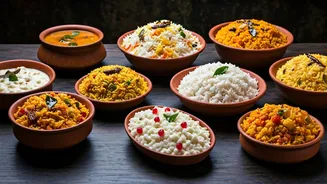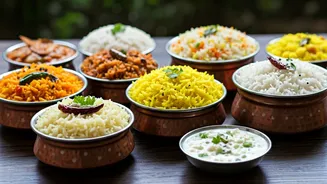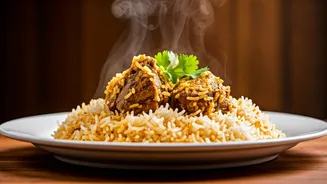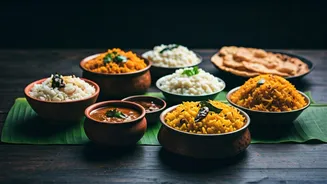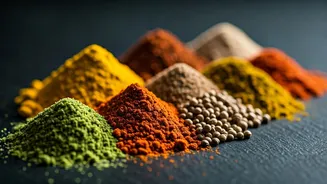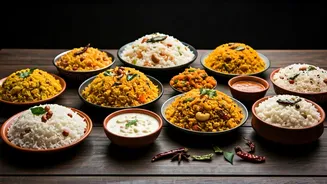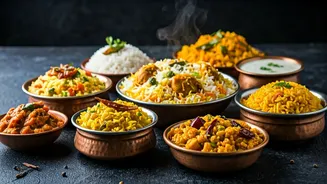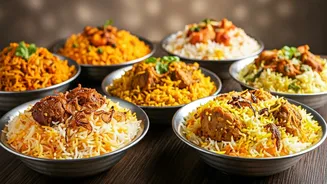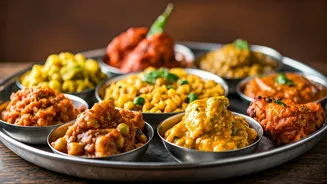Aromatic Tomato Rice
Tomato rice, a beloved dish in South India, features rice cooked with tomatoes, onions, and aromatic spices. The vibrant red hue comes from the tomatoes, and the flavor
profile is a delightful blend of tanginess and spice. Preparation typically involves sautéing onions and spices in oil, followed by the addition of tomatoes and rice. The dish often includes curry leaves and mustard seeds for an extra layer of flavor. It is a quick and satisfying meal, often enjoyed with raita or papadum. Regional variations may include additions like ginger-garlic paste or a touch of coconut milk, enhancing the complexity and creaminess of the dish. The simplicity of ingredients belies the depth of flavor.
Tamarind Rice Delight
Tamarind rice, also known as 'Puliyogare' in some regions, presents a tangy and savory experience. The key ingredient is tamarind pulp, which lends a sour and distinctive flavor. The preparation starts with the tempering of mustard seeds, urad dal, and chana dal. Next, the tamarind pulp is simmered with spices like red chilies, asafoetida, and turmeric. Finally, cooked rice is mixed in, absorbing the tangy flavors. Groundnuts or cashews are sometimes added for texture and crunch. The color is usually dark brown, and the dish has a long shelf life, making it a favorite for travel and picnics. It showcases the South Indian preference for sour and spicy food combinations.
Lemon Rice Zest
Lemon rice, a refreshing and zesty dish, provides a bright contrast to heavier meals. Fresh lemon juice infuses the rice with a citrusy aroma and flavor. The process begins with tempering mustard seeds, urad dal, and curry leaves. Then, cooked rice is mixed with lemon juice and turmeric, adding a vibrant yellow color. The addition of peanuts, cashews, and sometimes green chilies provides a delightful textural contrast. Lemon rice is a simple yet flavorful dish often enjoyed as a quick lunch or as part of a festive meal. The simplicity of its preparation makes it a popular choice across various South Indian households.
Coconut Rice Bliss
Coconut rice, a creamy and aromatic dish, highlights the use of fresh coconut. The preparation involves cooking rice with coconut milk, which imparts a rich flavor and aroma. The tempering is similar to other rice dishes, often including mustard seeds, curry leaves, and urad dal. Freshly grated coconut can also be added for extra texture and flavor. The dish is a popular offering during festivals and special occasions, especially in Kerala and coastal regions. It can be paired with vegetable curries or meat dishes. The delicate balance of flavors makes it a highly sought-after dish.
Curd Rice Comfort
Curd rice, a cooling and soothing dish, is a staple, especially in South India. It is prepared by mixing cooked rice with curd (yogurt) and seasoning it with salt. Tempering with mustard seeds, curry leaves, and sometimes green chilies can be added for extra flavor. The result is a simple, yet satisfying dish often eaten at the end of a meal to aid digestion. It is popular for its simplicity, ease of preparation, and health benefits, as curd is known for its probiotic properties. It's a quick fix that is both filling and gentle on the stomach. Variations may include adding chopped coriander leaves or pomegranate seeds for freshness and visual appeal.
Sambar Rice Symphony
Sambar rice is a hearty and flavorful dish that combines rice with sambar, a lentil-based vegetable stew. The sambar is prepared using various vegetables, lentils, and a special spice mix called sambar powder. Cooked rice is mixed with the sambar, absorbing the rich flavors. This dish is a complete meal in itself, providing a balance of carbohydrates, proteins, and vegetables. It's a popular choice for lunch and dinner and is often garnished with coriander leaves. Sambar rice is often served with a side of chutney or papadum. The combination of flavors is complex and satisfying.
Vegetable Biryani Extravaganza
Vegetable biryani, though not strictly a rice dish, holds a special place in South Indian cuisine. It involves layering rice with vegetables, spices, and sometimes paneer or other vegetarian proteins. The rice and vegetables are cooked together, often using the 'dum' method, where the dish is sealed and cooked over low heat to allow the flavors to meld. The resulting dish is fragrant and flavorful. Vegetable biryani is served as a celebratory dish, often during festivals and special occasions, showcasing a variety of vegetables and aromatic spices. The careful layering and slow cooking process contribute to its rich taste.
Pongal Celebration
Pongal, a traditional rice dish, holds immense cultural significance, especially during the Pongal festival. Sweet Pongal, made with rice, lentils, jaggery, and ghee, is a sweet preparation. Savory Pongal, made with rice, lentils, and spices, is another variant. Both versions are prepared with love and often offered as a thanksgiving to the sun god. The preparation varies by region, but the core ingredients of rice, lentils, and ghee remain consistent. Pongal is cooked in a clay pot and symbolizes prosperity and abundance. The sweet version often includes nuts and raisins, offering a delightful blend of textures and flavors, and savory version is a quick and satisfying breakfast option.
